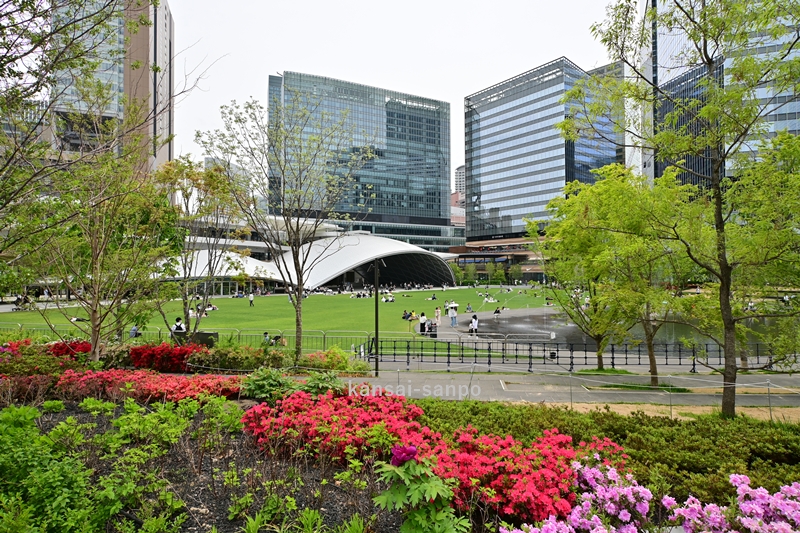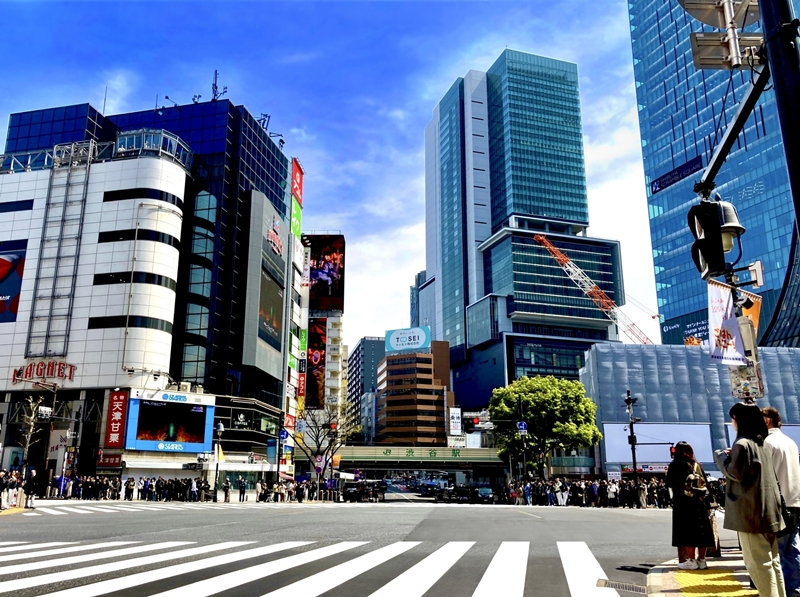
グラングリーン大阪(JR大阪駅北側)
日本には東京・大阪をはじめ、商業・文化・交通が集積する多くの都市があります。
ここでは「人口・人流」「商業施設の集積」「交通利便性」「再開発の規模」という4つの指標を基に、主要エリアの都会度を総合評価し、ランキング形式で紹介します。
あくまで公開統計や開発計画を参考にした目安であり、街の魅力を数値化したものではない点を前提としてご覧ください。
| 順位 | エリア | 総合ポイント |
|---|---|---|
| 1位 | 新宿(東京都) | 96 |
| 2位 | 梅田(大阪駅周辺) | 90 |
| 3位 | 渋谷(東京都) | 88 |
| 4位 | 池袋(東京都) | 84 |
| 5位 | 横浜(横浜駅周辺) | 82 |
| 6位 | 名古屋(名古屋駅周辺) | 80 |
| 7位 | 銀座(東京都) | 76 |
| 8位 | 天神(福岡市) | 75 |
| 9位 | 札幌(札幌駅と大通周辺) | 73 |
| 10位 | 難波(大阪市) | 70 |
| 11位 | 神戸(三宮駅周辺) | 68 |
| 12位 | 京都(四条河原町駅周辺) | 66 |
| 評価項目 | 内容 | 配点(満点) |
|---|---|---|
| 人口・人流 | 昼間人口、駅乗降客数、観光客数などの規模 | 25 |
| 商業施設 | 百貨店、商業ビル、地下街、ブランド店舗などの集積度 | 25 |
| 交通利便性 | 鉄道網、空港へのアクセス、路線数 | 25 |
| 再開発規模 | 進行中・計画中を含む大規模開発プロジェクト | 25 |
| 順位 | エリア | 人口・人流 | 商業施設 | 交通利便性 | 再開発規模 | 総合 |
|---|---|---|---|---|---|---|
| 1位 | 新宿 | 25 | 24 | 24 | 23 | 96 |
| 2位 | 梅田 | 22 | 23 | 23 | 22 | 90 |
| 3位 | 渋谷 | 23 | 23 | 21 | 21 | 88 |
| 4位 | 池袋 | 21 | 22 | 21 | 20 | 84 |
| 5位 | 横浜 | 20 | 21 | 21 | 20 | 82 |
| 6位 | 名古屋 | 20 | 20 | 20 | 20 | 80 |
| 7位 | 銀座 | 18 | 23 | 17 | 18 | 76 |
| 8位 | 天神 | 19 | 19 | 18 | 19 | 75 |
| 9位 | 札幌 | 18 | 18 | 18 | 19 | 73 |
| 10位 | 難波 | 18 | 19 | 17 | 16 | 70 |
| 11位 | 神戸 | 17 | 17 | 17 | 17 | 68 |
| 12位 | 京都 | 16 | 17 | 16 | 17 | 66 |
1位:新宿(東京都)

世界最大級のターミナル駅を中心に、商業・オフィス・行政機能が高密度に集積。駅周辺の乗降客数は世界トップクラスで、昼夜を問わず活気が続きます。
2位:梅田(大阪駅周辺)

グラングリーン大阪(JR大阪駅北側)
関西最大のビジネス・交通拠点。阪急・阪神・大阪メトロ(地下鉄)が集積し、百貨店や大型商業施設が充実しています。
グラングリーン大阪(うめきた2期)などの再開発も進行中で、2027年春までには、レジデンスタワー(2棟・最高価格25億円)や「うめきた公園(北公園)」が全面開業予定で、エリア価値は今後さらに上昇する可能性があります。
2030年代には、阪急電車「大阪梅田駅」と直結する高さ180m級の超高層ターミナルビル「芝田1丁目計画」が完成する予定です。梅田エリアの新たなランドマークとして注目されています。
3位:渋谷(東京都)

若者文化とIT産業の拠点。渋谷スクランブルスクエアなど再開発により都市景観が刷新されています。
4位:池袋(東京都)
副都心として大規模商業施設が集積。東西に広がる百貨店街や再開発計画が特徴です。
5位:横浜(横浜駅周辺)
みなとみらい地区と連携した都市景観が整備され、観光・商業の両面で存在感を示しています。
6位:名古屋(名古屋駅周辺)
リニア中央新幹線開業を見据えた再開発が進行中。JRセントラルタワーズを中心とする高層ビル群が象徴的です。
7位:銀座(東京都)
世界的ブランドが並ぶ日本有数の高級商業エリア。商業集積度は極めて高い一方、人口規模やターミナル機能は新宿や渋谷に比べ控えめです。
8位:天神(福岡市)
九州最大の商業地。天神ビッグバン計画によりオフィスや商業施設の拡充が進んでいます。
9位:札幌(札幌駅・大通周辺)
北海道の経済・行政の中心。駅周辺再開発により都市機能がさらに向上しつつあります。
10位:難波(大阪市)
道頓堀や心斎橋に近く、観光・商業が交わる大阪を代表する繁華街。南海なんば駅を中心に再開発計画も進行中で、観光都市大阪の玄関口として独特の活気があります。
11位:神戸(三宮周辺)
港町として発展してきた歴史ある都市。商業施設や交通の利便性は安定しており、再開発によってオフィス・商業機能の強化が進んでいます。
12位:京都(四条河原町周辺)
世界的観光都市として歴史と文化に特徴。高層開発は抑えられていますが、観光・商業のバランスが取れた都市機能を持ちます。
Urban Sophistication Ranking of Major Japanese Cities – TOP 12
— Analyzing Population, Commerce, Transportation, and Redevelopment
Japan is home to many vibrant urban centers led by Tokyo and Osaka.
This ranking evaluates 12 major city districts based on population & human flow, commercial facilities, transport connectivity, and redevelopment scale.
The scores are intended as a reference index derived from public data and redevelopment plans; they are not an absolute measure of each city’s charm.
| Rank | Area | Total Points |
|---|---|---|
| 1 | Shinjuku (Tokyo) | 96 |
| 2 | Umeda (Osaka Station area) | 90 |
| 3 | Shibuya (Tokyo) | 88 |
| 4 | Ikebukuro (Tokyo) | 84 |
| 5 | Yokohama (around Yokohama Station) | 82 |
| 6 | Nagoya (around Nagoya Station) | 80 |
| 7 | Ginza (Tokyo) | 76 |
| 8 | Tenjin (Fukuoka) | 75 |
| 9 | Sapporo (Sapporo Station / Odori) | 73 |
| 10 | Namba (Osaka) | 70 |
| 11 | Kobe (Sannomiya area) | 68 |
| 12 | Kyoto (Shijo–Kawaramachi area) | 66 |
Highlights of Each Area
1. Shinjuku (Tokyo) – 96 points
One of the busiest transport hubs in the world, with unmatched passenger numbers and a dense mix of business, government, and entertainment facilities.
2. Umeda (Osaka Station area) – 90 points
The largest business and transport center in western Japan. Major redevelopment such as the Ume-kita Phase 2 project is ongoing, steadily enhancing commercial and office functions.
3. Shibuya (Tokyo) – 88 points
A global center for youth culture and IT business, now undergoing large-scale redevelopment including Shibuya Scramble Square.
4. Ikebukuro (Tokyo) – 84 points
A sub-center of Tokyo featuring large department stores and ambitious redevelopment plans on both east and west sides of the station.
5. Yokohama (around Yokohama Station) – 82 points
Japan’s second-largest city by population, integrating the Minato Mirai waterfront with strong commercial and tourism appeal.
6. Nagoya (around Nagoya Station) – 80 points
Home to JR Central Towers and multiple skyscrapers, with the future Linear Chuo Shinkansen (maglev) expected to accelerate growth.
7. Ginza (Tokyo) – 76 points
Japan’s premier luxury shopping district, internationally renowned for high-end retail though smaller in population and transport scale.
8. Tenjin (Fukuoka) – 75 points
Kyushu’s largest commercial center. The “Tenjin Big Bang” redevelopment is expanding office and retail capacity.
9. Sapporo (Sapporo Station / Odori) – 73 points
The economic and administrative heart of Hokkaido, with ongoing station-area redevelopment projects.
10. Namba (Osaka) – 70 points
A vibrant entertainment and shopping district near Dotonbori and Shinsaibashi, serving as a key southern gateway to Osaka.
11. Kobe (Sannomiya area) – 68 points
A historic port city with a balanced mix of commercial and residential functions. Sannomiya Station redevelopment is gradually strengthening its urban core.
12. Kyoto (Shijo–Kawaramachi area) – 66 points
A world-renowned tourist city. High-rise development is restrained to preserve its cultural heritage, yet the commercial area remains strong.
Summary
While Tokyo districts occupy most of the top ranks, Umeda, Tenjin, and Kobe highlight the strength of Japan’s regional centers.
This ranking is intended as a comparative reference based on measurable urban factors, but the true appeal of each city lies equally in culture, history, and the daily lives of its residents and visitors.

